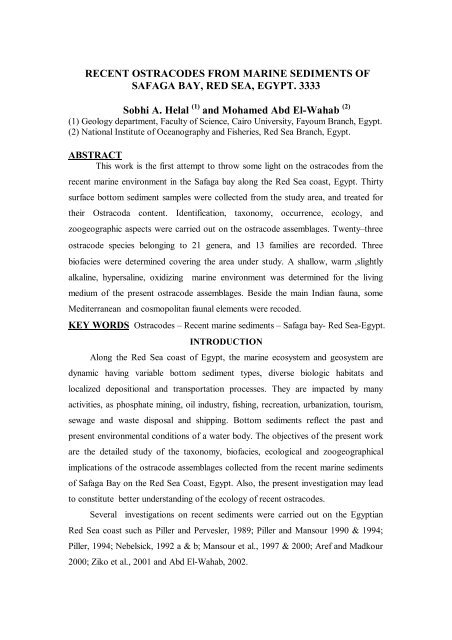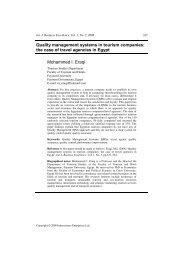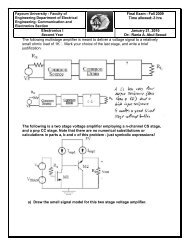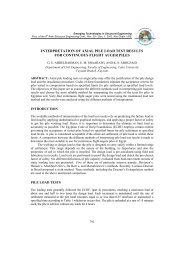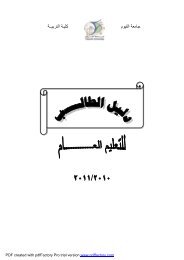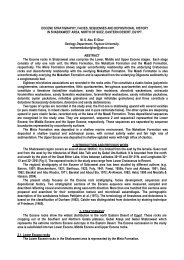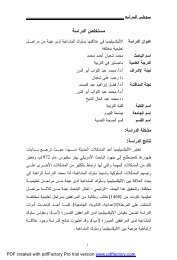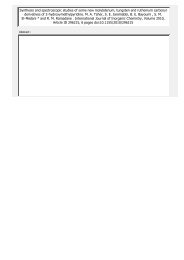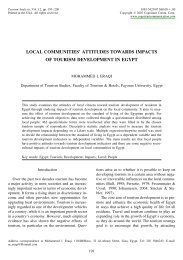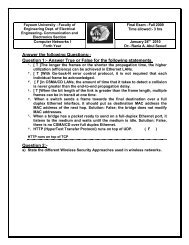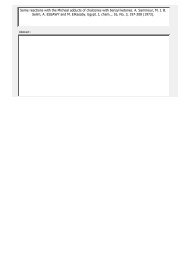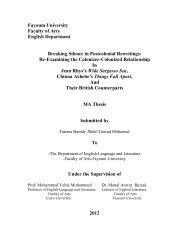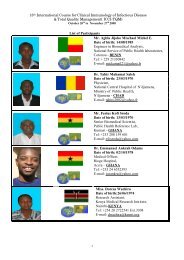RECENT OSTRACODES FROM MARINE SEDIMENTS OF SAFAGA ...
RECENT OSTRACODES FROM MARINE SEDIMENTS OF SAFAGA ...
RECENT OSTRACODES FROM MARINE SEDIMENTS OF SAFAGA ...
Create successful ePaper yourself
Turn your PDF publications into a flip-book with our unique Google optimized e-Paper software.
<strong>RECENT</strong> <strong>OSTRACODES</strong> <strong>FROM</strong> <strong>MARINE</strong> <strong>SEDIMENTS</strong> <strong>OF</strong><br />
<strong>SAFAGA</strong> BAY, RED SEA, EGYPT. 3333<br />
Sobhi A. Helal (1) and Mohamed Abd El-Wahab (2)<br />
(1) Geology department, Faculty of Science, Cairo University, Fayoum Branch, Egypt.<br />
(2) National Institute of Oceanography and Fisheries, Red Sea Branch, Egypt.<br />
ABSTRACT<br />
This work is the first attempt to throw some light on the ostracodes from the<br />
recent marine environment in the Safaga bay along the Red Sea coast, Egypt. Thirty<br />
surface bottom sediment samples were collected from the study area, and treated for<br />
their Ostracoda content. Identification, taxonomy, occurrence, ecology, and<br />
zoogeographic aspects were carried out on the ostracode assemblages. Twenty–three<br />
ostracode species belonging to 21 genera, and 13 families are recorded. Three<br />
biofacies were determined covering the area under study. A shallow, warm ,slightly<br />
alkaline, hypersaline, oxidizing marine environment was determined for the living<br />
medium of the present ostracode assemblages. Beside the main Indian fauna, some<br />
Mediterranean and cosmopolitan faunal elements were recoded.<br />
KEY WORDS Ostracodes – Recent marine sediments – Safaga bay- Red Sea-Egypt.<br />
INTRODUCTION<br />
Along the Red Sea coast of Egypt, the marine ecosystem and geosystem are<br />
dynamic having variable bottom sediment types, diverse biologic habitats and<br />
localized depositional and transportation processes. They are impacted by many<br />
activities, as phosphate mining, oil industry, fishing, recreation, urbanization, tourism,<br />
sewage and waste disposal and shipping. Bottom sediments reflect the past and<br />
present environmental conditions of a water body. The objectives of the present work<br />
are the detailed study of the taxonomy, biofacies, ecological and zoogeographical<br />
implications of the ostracode assemblages collected from the recent marine sediments<br />
of Safaga Bay on the Red Sea Coast, Egypt. Also, the present investigation may lead<br />
to constitute better understanding of the ecology of recent ostracodes.<br />
Several investigations on recent sediments were carried out on the Egyptian<br />
Red Sea coast such as Piller and Pervesler, 1989; Piller and Mansour 1990 & 1994;<br />
Piller, 1994; Nebelsick, 1992 a & b; Mansour et al., 1997 & 2000; Aref and Madkour<br />
2000; Ziko et al., 2001 and Abd El-Wahab, 2002.
GEOLOGICAL SETTING<br />
The Safaga area is occupied by relatively low hills of sedimentary rocks and is<br />
surrounded by mountaineous area of igneous and metamorphic rocks. Safaga bay is a<br />
shallow water bay with a maximum water depth of 70m, and it is situated on the west<br />
coast of the Red Sea on Egyptian territory between 33 o 56 \ and 34 o longitude and<br />
between 26 o 37 \ and 26 o 52 \ northern latitude (Fig. 1). The bay is bordered by a<br />
narrow arid coastal plain on the westewards, and its east and southwards by very<br />
steep slope, while the northern border is formed by the prominent peninsula of Ras<br />
Abu Soma. The N-S oriented Safaga Island (Gazirat Safaga) equally subdivides the<br />
bay into a northern and a southern part. Both parts are distinctly separated by a shoal<br />
and connected only by a narrow channel.<br />
Additionally, the prevailing water current from north to south prevents the<br />
harbor of Safaga, which is situated in the southern part, from influencing the northern<br />
bay. The southern bay is deepest than the northern one. Various bottom facies were<br />
observed such as coral reefs, sand bottoms, seagrass bottoms and mud bottoms. The<br />
northern bay is characterized by common occurrence of coral reef communities,<br />
seagrass beds and pure sand bottoms especially at the base of the steeper slope which<br />
is inhabited by coral reefs, while the southern bay is famous with mud bottoms, coral<br />
reefs are less abundant and consists mainly of soft one.<br />
CLIMATE AND OCEANOGRAPHIC INFLUENCES<br />
The climate of the Red Sea is largely controlled by the distribution of winds<br />
and change in atmospheric pressure over a very wide area. Over the whole year winds<br />
from NW to NE predominate. Generally, wind velocity is distinctly higher during the<br />
daytime, a phenomenon that can be explained by the higher temperature differences<br />
between the stronger heated landmass and sea water. Considerably, the water level<br />
changes periodically as a result of thermally driven winds, blowing landward in<br />
daytime. Winds also create a mainly NE-SW oriented water motion. This leads to<br />
distinct higher waves in the exposed area than in the protected parts and drives<br />
longshore current in summer southward. Waves and currents redistribute terrigenous<br />
debris brought into the sea either by wadis or NW winds on the tidal flat area<br />
(Mansour, 1995).<br />
٢
Because of permanent air and water turbulence, a complete mixing of water<br />
column occurs and no stratification is developed inside the water body. This is<br />
reflected also by the values of temperature and salinity, which show no significant<br />
differences between surface and bottom waters (Piller and Pervesler, 1989). The tide<br />
is semidiurnal, maximum peak every 12 h with a mean tidal range of about 0.5m. The<br />
water depth in the high level tide from the bottom surface is about 0.90m and water<br />
depth in the low tide is about 0.30m.<br />
The rainfall over the Red Sea is extremely small, mostly in the form of short<br />
duration winter showers, amounting to some 10 - 15mm/year (Morcos, 1970). A close<br />
relationship is observed between air and sea surface temperatures. Water temperature<br />
clearly reflects seasonal changes (summer: 28-29 O C, winter: 21-23 O C). In shallow<br />
area, higher values were measured due to solar radiation. In June 2001 all<br />
oceanographic parameters were measured in Safaga area (Table 1). Water<br />
temperature varies from 22 o C to 28.82 o C, salinity from 40.36 to 42.3 ‰, pH values<br />
between 7.07 and 8.34 , dissolved oxygen from 6.08 to 7.98 mg/l., total dissolved<br />
salts from 39.06 to 39.46 g/l, oxidation reduction potential between 390 and 429 mv,<br />
and specific conductivity from 61.5 to 61.73 ms/cm.<br />
MATERIAL AND METHODS<br />
Surface marine sediment samples were collected in summer 2001 for Safaga<br />
bay, depth of samples ranges from beach sediments to 34m below (Table 1 & Fig. 1).<br />
Thirty samples were collected either by grab sampler in deep water, or by hand at the<br />
beach at different distances from the shoreline and along it .<br />
Oceanographic parameters that control the coastal features of the Red Sea,<br />
such as salinity, water temperature, pH and dissolved oxygen were determined on a<br />
sample of overlying seawater for each sample. Moreover, most of these parameters,<br />
especially water temperature (Temp.), pH, salinity (S), total dissolved salts (TDS),<br />
specific conductivity (Spc) dissolved oxygen (Do) and oxidation reduction potential<br />
(Eh) were measured in the summer 2001 (June) at each sample using Hydrolab<br />
Surveyor - 4 Model Instruments and data are summarized in table (1).<br />
The obtained samples are investigated for their Ostracoda content. The bottom<br />
sediments are treated by normal washing techniques traditionally used for the<br />
extraction of ostracods in the micropaleontological laboratory of the U.S. geological<br />
survey and summarized by Sohn (1961) in the treatise (Moore eds., 1961). 100 gm of<br />
٣
the washed residue are inspected and the obtained taxa are counted and the results are<br />
introduced in table (2).<br />
OSTRACOD ASSEMBLAGES<br />
The distribution, occurrence and density of the recorded taxa led to the<br />
differentiation between three assemblages.<br />
Biofacies I<br />
This biofacies is recorded from the southern bay. It is the more dense and<br />
diversified one. This assemblage consists of the following species: Xestoleberis<br />
rhomboidea, Xestoleberis rotunda, Loxocorniculum ghardaquensis, Loxoconcha<br />
sp.A, Moosella striata, Caudites levis, Neonsidea schulzi, Paranesides sp.,<br />
Leptocoythere rara, Alocopocythere reticulata, Miocyprideis cf. spinulosa,<br />
Miocyprideis sp., Tanella gracilis, Eucytherura complexa, Cytherelloidea sp. A,<br />
Aglaiocypris triebeli, Pontocypris sp. A, Thalmania sp., Paracytheridea remanei,<br />
Cythereis rubrimaris, Cytherepteron sp., and Cytherella cf. punctata.<br />
This association is dominated by six species: Alocopocythere reticulata,<br />
Miocyprideis sp., Aglaiocypris tribeli, Loxocorniculum ghardaquensis, Xestoleberis<br />
rhamboidea, Xestoleberis rotunda and Miocyprideis cf. spinulosa. The former four<br />
species are very rare in the northern bay.<br />
Furthermore, four species are restricted to biofacies I and are not recorded in<br />
the other associations. These species are Leptocoythere rara, Cytherelloidea sp.,<br />
Thalmania sp. and Caudites levis.<br />
Biofacies II<br />
The biofacies II is localized in the northern bay, it is dominated by ten<br />
species: Neonesidea schulzi, Loxocorniculum ghardaquensis, Xestoleberis rotunda,<br />
Loxoconcha ornatovalvae, Cythereis rubrimaris, Alocopocythere reticulata,<br />
Moosella striata., Paranesidea sp. and Xestoleberis rhomboidea. The following eight<br />
species are also present but with rare occurrences: Cytherella cf. punctata,<br />
Cytherepteron sp., Aglaiocypris triebeli, Tanella gracilis, Miocyprideis sp.,<br />
Paracytheridea remanei, Miocyprideis cf. spinulosa and Eucytherura complexa.<br />
Biofacies III<br />
This biofacies is restricted to the channel connecting the two bays and<br />
bordered seaward by the Safaga Island. The community is generally poor and less<br />
٤
diversified. The density of the recorded species are don’t exceed 4 carapaces, nine<br />
species are recorded by 2-4 carapaces: Xestoleberis rhomboidea, Loxoconcha sp.A,<br />
Cythereis rubrimaris , Neonesidea schulzi, Paranesidea sp., Alocopocythere<br />
reticulata, Miocyprideis cf. spinulosa and Aglaiocypris triebeli.<br />
There are also five species each represented by only one carapace: Xestoleberis<br />
rhamboidea, Loxocorniculum ghardaquensis, Moosella striata, Paracytheridea<br />
remanei and Cytheropteron sp.<br />
ZOOGEOGRAPHY<br />
Of the 23 Ostracoda species recognized from the Safaga Bay, the following 14<br />
species are known to occur in the Persian Gulf, Abu Dhabi Lagoon: Neonesidea<br />
schulzi (Hartmann); Paranesidea sp. Bate; Aglaiocypris triebeli (Hartmann);<br />
Cytherella cf. punctata Brady, Pontocypris sp.B Bate, Alocopocythere reticulata<br />
(Hartmann); Xestoleberis rhomboidea Hartmann; Loxoconcha sp.A Bate ;<br />
Cytherelloidea sp. A Bate; Carinocythereis cf. hamata (Kingma); Moosella striata<br />
Hartmann; Xestoleberis rotunda Hartmann and Thalmannia sp. Bate. Whether these<br />
species migrated from the Red Sea to the Persian Gulf or vice versa is not know. It is<br />
more probable, of course, that the species entered both regions from the Indian Ocean<br />
independently (Bate 1970). Moreover, Bate (op. cit) noticed that some species<br />
common to the Persian Gulf and the Red Sea are also present in East Africa (off<br />
Bagamoyo,Tanzania). Several elements of Red Sea ostracodes are also related to, if<br />
not actually conspecific with, Cenozoic species described by Knigma (1948) from<br />
Indonesia; e.g.: Tanella gracilis Kingma from Safaga Bay is identical to Tanella<br />
gracilis Kingma, described from the Lower and Upper Pliocene of Sumatra and Java<br />
respectively. Carinocythereis cf. hamata (Kingma) present in Safaga Bay appears to<br />
be closely related to Cythereis hamata Kingma, recorded from the Lower Pliocene of<br />
Sumatra. Cytherella cf. punctata Brady, is close to Cytherella punctata Brady,<br />
described from the Lower Pliocene to Pleistocene of eastern Java.<br />
A number of Safaga Bay ostracodes show affinities to Mediterranean or even<br />
cosmopolitan species: these species include Leptocythere rara (Mueller),<br />
Miocyprideis cf spinulosa (Brady), Eucytherura complexa (Brady), and Tanella<br />
gracilis Kingma . The presence of the Mediterranean fauna may be attributed to<br />
dispersal and migration. This may take place through passive migration, interesting<br />
٥
case in this category is that of Potamocypris humilis cited by Green (1961). This<br />
South African species is also found in rock pools on the south coast of Finland and<br />
Greenland, this is explained by the fact that both land masses lie along the migration<br />
route of the Arctic and Common Terns which overwinter in South Africa and suggests<br />
that P. humilis or its eggs may be carried by these birds (Neale 1964). A similar<br />
mechanism can be proposed for the study area. Several species of the European birds<br />
migrate to the Red Sea coast where they overwinter passing across the Mediterranean<br />
Sea. Moreover, ships may contribute in this context as the southern Safaga Bay is<br />
used as a harbour. Great number of ships move between Red Sea and Mediterranean<br />
Sea through the Suez Canal. According to Teeter(1973) man may inadvertently assist<br />
interoceanic dispersal through the Suez and Panama Canals by the use of water ballast<br />
during ship passage .The floating marine plants also play an important role and serve<br />
as another tool in passive migration .<br />
TAXONOMIC DESCRIPTION<br />
The present taxonomic work lead to the identification of twenty three species<br />
belonging to twenty one genera and fourteen families. Occurrence and ecology are<br />
given for each identified species. Table (2) shows the taxonomic list, the total<br />
numbers of the studied species, percentage and their occurrence.<br />
Order: Podocopida Müller, 1894.<br />
Suborder: Podocopina Sars, 1866.<br />
Superfamily: Bairdiacea Sars, 1888.<br />
Family: Bairdiidae Sars, 1888.<br />
Genus: Paranesidea Maddocks, 1969.<br />
Paranesidea sp Bate.<br />
(Pl.1 , Fig. 1 ).<br />
1970 Paranesidea sp.- Bate, P 246, Pl. 1, Fig. 1j.<br />
Occurrence: The largest population of this species was obtained from samples<br />
no. 27, 24 and 6 (11, 7 and 6 carapaces respectively). It constitutes 2.893% of the<br />
studied ostracodes taxa.<br />
Ecology: It is distributed in bottom sediments from sand to sandy silt at depths<br />
(17-33.5m). The oceanographic parameters are as follows: salinity ranges from 41.38<br />
to 42.30‰; pH ranges from 7.07-8.18 and Eh from 392-401.<br />
Zoogeography: Indian Ocean and Persian Gulf (Bate,1970 ).<br />
٦
Genus: Neonesidea Maddocks, 1969<br />
Neonesidea schulzi (Hartmann)<br />
(Pl. 1 , Fig. 2 )<br />
1964 Triebelina schulzi n.sp. Hartmann,p.44,pl.4,5,figs.14-22 .<br />
1970 Neonesidea schulzi (Hartmann) – Bate, P. 246, Pl. 1, Fig. 1i.<br />
Occurrence: This species attains its highest occurrence in samples no. 27 and 20 (7<br />
& 6 carapaces respectively). It represents 2.81% of the total ostracodes taxa.<br />
Ecology: This cosmopolitan species occurs in the northern bay sandy silt sediments at<br />
depths (25.4 - 33.5m), average value of ecological conditions are : salinity (41.51‰);<br />
pH (7.13) and Eh is (391).<br />
Zoogeography: Indian Ocean and Persian Gulf (Bate,1970) .<br />
Superfamily: Cypridacea Baird, 1845<br />
Family: Paracyprididae Sars, 1923<br />
Genus: Aglaiocypris Sylvester-Bradly, 1946<br />
Aglaiocypris triebeli (Hartmann)<br />
(Pl. 1 , Fig. 3 ).<br />
1964 Ghardaglaia triebeli n. sp. Hartmann,p.41,pl.6-9,figs.23-40.<br />
1970 Aglaiocypris triebeli (Hartmann) – Bate, P. 246, Pl. 1, Fig. 1w.<br />
Occurrence: This species is widely distributed in the southern bay. The highest<br />
population is recorded from samples no. 1, 3 and 12 (36, 22 & 21 carapaces<br />
respectively). It constitutes 8.66% of the studied ostracodes species.<br />
Ecology: It is recorded at depths (zero - 34m) from sand to mud bottom sediments.<br />
oceanographic parameters : salinity ranges from 40.96 to 41.36 ‰; pH have average<br />
value of 8.24 and Eh value ranges from 394 to 421.<br />
Zoogeography: Indian Ocean and Persian Gulf (Bate,1970).<br />
Family: Pontocyprididae Müller, 1894<br />
Genus: Pontocypris Sars, 1866<br />
Pontocypris sp. B Bate<br />
(Pl. 1 , Fig. 4 )<br />
1970 Pontocypris sp.B-Bate,p.264,pl.1,fig.1h.<br />
٧
Occurrence: Rare specimens of this species were found in the southern bay from<br />
samples no. 1 and 3 (3 & 4 carapaces respectively). It represents 1.29% of the total<br />
ostracod fauna.<br />
Ecology: This species was distributed in very shallow water muddy sand sediments at<br />
depth ranging from 5.3 to 10m. Ecological factors are as follows : salinity varies<br />
between 40.96 and 42.60 ‰; pH ranges from 6.88 to 8.21 and Eh varying from 421<br />
and 390.<br />
Zoogeography: Indian Ocean and Persian Gulf (Bate,1970).<br />
Superfamily: Cytheracea Baird, 1850<br />
Family: Leptocytheridae Hanai, 1957<br />
Genus: Leptocythere Sars, 1927<br />
Leptocythere rara (G.W. Müller)<br />
(Pl. 1 , Fig. 5 )<br />
1894 Leptocythere rara n. - G. W. Müller, 1894, P. 355, T. 29, FF. 12 & 14.<br />
1974 Leptocythere rara (G. W. Müller, 1894) - Ruggieri, P. 432, Fig. 5.<br />
Occurrence: Few specimens were recorded from the southern bay in the samples no.<br />
1 and 7 (3 & 11 carapaces respectively). It represents 1.06% of the total ostracod<br />
species.<br />
Ecology: Dense population is found at depth 20m where its frequency increases in the<br />
muddy sand. Oceanographic parameters have average values of : salinity (41.34 ‰);<br />
pH (8.21) and Eh (400).<br />
Zoogeography: Mediterranean Sea (Ruggieri, 1974).<br />
Genus: Tanella Kingma, 1948<br />
Tanella gracilis Kingma<br />
(Pl. 1 , Fig. 6 )<br />
1973 Tanella gracilis Kingma -Teeter, P. 51, Fig. 2 i-p.<br />
Occurrence: Rare specimens of this species were recorded from samples no. 1, 19<br />
and 20 (1, 1 & 2 carapace). It represents 0.30% of the total ostracod taxa.<br />
Ecology: The samples no.1 & 19 is beach samples while sample no. 20 is collected at<br />
a depth of 25.4m from sand to sandy silt bottom facies. Oceanographic parameters:<br />
average value of salinity is 41.5 ‰; pH (7.2) and Eh (391).<br />
Zoogeography: Cosmopolitan (Teeter,1973).<br />
Order: Podocopida Müller, 1894<br />
Suborder: Podocopina Sars, 1866<br />
٨
Superfamily: Cytheracea Baird, 1850<br />
Family: Hemicytheridae Puri, 1953<br />
Subfamily: Orionininae Puri, 1974<br />
Genus: Caudites Coryell & Fields, 1937<br />
Caudites levis Hartmann<br />
(Pl.1 , Fig.7 )<br />
1964 Caudites levis n. sp. Hartmann, P. 117, Pl.55, Fig. 311-316.<br />
Occurrence: This species is rare and only recorded in the sample no 1 (two<br />
carapaces). It represents 0.15% of the total ostracod species.<br />
Ecology: It is recorded from the beach sediments of the southern bay.<br />
Zoogeography: Red Sea (Hartmann,1964).<br />
Family: Campylocytheridae Puri, 1960<br />
Genus: Alocopocythere Siddiqui, 1971<br />
Alocopocythere reticulata (Hartmann)<br />
(Pl. 1 , Fig. 8 )<br />
1964 Bradleya reticulata n.sp.Hartmann,p.108,pl.46,fig.269;pl.47-49,figs.274-288 .<br />
1970 Alocopocythere reticulata (Hartmann) – Bate, P. 246, Pl. 1, Fig. 2PP.<br />
Occurrence: This species is widely distributed in the southern bay and the more<br />
dense population is recorded from samples no. 7 and 15 (44 & 19 carapaces<br />
respectively). It constitutes 12.54% of the studied ostracode species.<br />
Ecology: Exceptional dense population of this species is recorded from sample no. 7<br />
in muddy sand sediment at water depths (25.7 - 26.9m). Average value of salinity<br />
(41.36 ‰); pH (8.19) and Eh (398) .<br />
Zoogeography: Indian Ocean and Persian Gulf (Bate,1970).<br />
Family: Cytherideidae Sars, 1925<br />
Subfamily: Cytherideinae Sars, 1925<br />
Genus: Miocyprideis Kollmann, 1960<br />
Miocyprideis cf. spinulosa (G. S. Brady)<br />
(Pl.1 , Fig. 9 )<br />
1868 Cytheridea spinulosa n. sp. G. S. Brady, P. 182-183, Pl. 8, Fig. 1-6.<br />
1880 Cytheridea spinulosa G. S. Brady, P. 112, Pl. 33, Fig. 6a-d.<br />
1960 Miocyprideis spinulosa (Brady)-Kollmann, P.178, Pl.18, Figs.12-13, Pl. 19,<br />
Fig.16.<br />
٩
1971 Miocyprideis cf. spinulosa (G. S. Brady)-Gramann,P.124,Pl.15,Figs.8-10.<br />
Occurrence: This cosmopolitan species was found in the southern bay from the<br />
samples no. 9, 12 and 7 (17, 14 & 12 carapaces respectively). It represents 6.23% of<br />
the total ostracod species.<br />
Ecology: This species is recorded from muddy sand facies at depth averaging 25.7m.<br />
Oceanographic parameters : salinity; pH and Eh are 41.37 ‰; 8.24 and 397<br />
respectively.<br />
Zoogeography:Cosmopolitan (Kollmann,1960 ; Gramann,1971).<br />
Miocyprideis sp.<br />
(Pl.1 , Fig. 10 )<br />
Description: Carapace of medium size, about 0.7mm length. Subrectangular in<br />
lateral view, both ends well rounded. Dorsal margin nearly straight, ventral outline<br />
slightly convex. Anterior and posterior margins very weakly denticulated. Left valve<br />
slightly larger than right valve and overlaps it ventrally, surface pitted.<br />
Internal features : Not accessible.<br />
Occurrence: Few numbers of the species are found in the southern bay from the<br />
samples no. 7, 9, 11 and 12 (3, 5, 7 & 9 carapaces respectively). It constitutes 2.13%<br />
of the studied ostracodes species.<br />
Ecology: It is recorded from muddy sand bottom sediments at depth of about 25.7m.<br />
The value of salinity (41.39‰); pH (8.27) and Eh (397).<br />
Zoogeography: Red Sea.<br />
Family: Cytheruridae Müller, 1894<br />
Subfamily: Cytherurinae Müller, 1894<br />
Genus: Eucytherura Müller, 1894<br />
Eucytherura complexa (Brady)<br />
1985 Eucytherura complexa (Brady)–Guillaume et al., P. 352, Pl. 104, Figs. 5-6.<br />
Occurrence: This species is rare and its occurrence didn’t exceed two carapaces in<br />
any samples ( e. g. sample no. 2, 13 and 20). It represents 0.99% of the total ostracod<br />
taxa.<br />
Ecology: It is found in bottom sediments from sand to sandy silt at depths (2 -<br />
25.4m). The measured Ecological factors are : salinity ranges from 40.46 to 41.50<br />
‰; pH from 7.2 to 8.22 and Eh varies from 391 to 429.<br />
Zoogeography: Mediterranean Sea (Guillaume et al.1985).<br />
١٠
Subfamily: Cytheropterinae Hanai, 1957<br />
Genus: Cytherepteron Sars,1866<br />
Cytherepteron sp.<br />
Description: Carapace small to medium size, inflated with ventral swelling. Caudal<br />
process pronounced and acuminate. Lateral view oval with two subcentral to<br />
posteroventral, tapering wings.<br />
Internal Features: Not accessible.<br />
Occurrence: Few specimens of this species were recorded in the studied area. The<br />
highest population (only two carapaces) is recorded from samples no. 12, 13 and 16.<br />
It constitutes 1.06% of the studied ostracode species.<br />
Ecology: This species is found in the very fine sand to muddy sand bottom sediments<br />
at a depth range of 7-34m, while salinity (41.36 – 41.51‰); pH (8.08-8.32) and Eh<br />
(394 - 406).<br />
Zoogeography: Red Sea.<br />
Family: Cytheridea Baird, 1850<br />
Subfamily: Loxoconchinae Sars, 1825<br />
Genus: Loxoconcha Sars, 1866<br />
Loxoconcha sp. A Bate<br />
(Pl. 1 , Figs.11,12 )<br />
1970 Loxoconcha sp.A Bate, P. 246, Pl. 1, Fig. 1 , l .<br />
Occurrence: This species is widely distributed in the studied area, the highest<br />
population of this species is recorded from samples no. 20 and 6 (29 & 18 carapaces<br />
respectively). It represents 7.22% of the total ostracod taxa.<br />
Ecology: This species occurs commonly at depths ranges from 17 to 25.4m in the<br />
bottom facies varying from sandy silt to muddy sand. Oceanographic parameters:<br />
salinity between 41.38 and 41.50‰; pH from 7.20 to 8.18 and Eh ranges from 391 to<br />
401.<br />
Zoogeography:Indian Ocean and Persian Gulf (Bate,1970 ).<br />
Genus: Loxocorniculum Benson and Coleman, 1963<br />
Loxocorniculum ghardaquensis (Hartmann)<br />
(Pl. 1 , Fig. 13 )<br />
1964 Loxoconcha ghardaquensis n.sp.Hartmann,p.52,pl.15,figs.67-72;pl.16,figs.73-<br />
76;pl.17,figs.77-79;pl.18,figs.80-82.<br />
1970 Loxocorniculum ghardaquensis (Hartmann) – Bate, P. 254.<br />
١١
Occurrence: Moderate numbers of this widely distributed species occurs in the<br />
southern bay while rare numbers were found in the northern bay. The highest<br />
population of this species was recorded from samples no. 13, 2 and 1 (19, 14 & 11<br />
carapaces respectively). It constitutes 5.85% of the studied ostracod species.<br />
Ecology: It occurs in very shallow water at depths between (2 - 7m) and increases in<br />
the very fine sand. Ecological values : salinity ranges from 40.46 to 41.36 ‰; pH<br />
varies between 8.08 and 8.22, and Eh from 406 to 429.<br />
Zoogeography: Red Sea (Hartmann,1964).<br />
Family: Trachyleberididae Sylvester-Bradley, 1948<br />
Subfamily: Trachyleberidinae Sylvester-Bradley, 1948<br />
Genus: Carinocythereis Ruggieri, 1956<br />
Carinocythereis cf. hamata (Kingma)<br />
(Pl.1 , Fig.15 )<br />
1970 Carinocythereis cf. hamata (Kingma)-Bate, P. 246, Pl. 1, Fig. 1y.<br />
Occurrence: This species is only recorded in the channel connecting between<br />
southern and northern bays from sample no.18 (4 carapaces). It constitutes 0.30% of<br />
the studied ostracod species.<br />
Ecology: It is found in muddy sand sediments at a depth of 16.5m. The salinity; pH<br />
and Eh are 41‰; 8.13 and 393 respectively.<br />
Zoogeography :Indian Ocean and Persian Gulf (Bate,1970).<br />
Carinocythereis rubrimaris( Hartmann )<br />
(Pl. 1 , Fig. 14 )<br />
1964 Cythereis rubrimaris n.sp.Hartmann,p.115,pl.54,figs.306-310;pl.56,figs.317.<br />
Occurrence: Moderate numbers of this species were found in the studied area and<br />
the highest population were recorded in the southern bay from samples no. 2 and 7<br />
(21 & 8 carapaces respectively). It represents 5.40% of the total ostracod taxa.<br />
Ecology: The oceanographic parameters of this species are: salinity (40.46 -<br />
41.34‰); pH (8.22); Eh (400 – 429) and its habitat varies from sand to muddy sand<br />
sediments at depths of about 25.7m.<br />
Zoogeography: Red Sea (Hartmann,1964).<br />
Genus: Moosella Hartmann, 1964<br />
Moosella striata Hartmann<br />
(Pl. 1 , Fig. 16 )<br />
١٢
1964 Moosella striata n. sp. Hartmann,pl.46,figs.270-273;pl.50-51,figs.289-297.<br />
Occurrence: This species is found in moderate numbers from the studied area, the<br />
highest population is recorded from samples no. 2, 12, 13 and 25 (20, 17, 10 & 10<br />
carapaces respectively). It represents 8.74% of the total ostracod taxa.<br />
Ecology: It is common in the bottom facies that varies from sand to mud at depths<br />
between 2-34m; the average values of the physical conditions are salinity (41.32‰);<br />
pH (7.99) and Eh (405).<br />
Zoogeography: Red Sea (Hartmann,1964).<br />
Genus: Thalmannia Le Roy, 1939<br />
Type species: Thalmannia sumatraensis Howe ,1951<br />
Thalmannia sp. Bate<br />
1970 Thalmannia sp. Bate, P. 246, Pl. 1, Fig. 2x.<br />
Occurrence: This species is generally rare and is represented by only one carapace<br />
from each of the samples no. 6 and 7 in the southern bay. It constitutes 0.30% of the<br />
studied ostracodes species.<br />
Ecology: It is found in muddy sand sediment at depths between 17-20m and the<br />
ecological parameters are: salinity 41.36‰ ; pH and Eh 8.19 and 400.<br />
Zoogeography: Persian Gulf (Bate,1970).<br />
Family: Paracytherideidae Puri, 1957<br />
Subfamily: Paracytherideinae Puri, 1957<br />
Genus: Paracytheridea G. W. Müller, 1894<br />
Paracytheridea remanei Hartmann<br />
1964 Paracytheridea remanei Hartmann,p.65,pl.23,figs.114-120; pl.24,figs.121-124.<br />
Occurrence: Rare specimens of this species were found in the studied area from<br />
samples no. 18, and 19 (one carapace each) and sample no. 16 (two carapace). It<br />
represents 0.30% of the total ostracod taxa.<br />
Ecology: It is recorded rarely in muddy sand at depths between (0 – 28.8m), the<br />
average values of physical parameters are: salinity (41.25‰); pH (8.23) and Eh (393)<br />
Zoogeography: Red Sea (Hartmann,1964).<br />
Family: Xestoleberididae Sars, 1928<br />
Subfamily: Xestoleberidinae G. O. Sars, 1928<br />
Genus: Xestoleberis G. O. Sars, 1866<br />
Xestoleberis rhomboidea Hartmann<br />
(Pl.1 , Fig. 17 )<br />
١٣
1964 Xestoleberis rhomboidea n.sp. Hartmann, p.75,pl.32,33,figs.177-186 .<br />
1970 Xestoleberis rhomboidea Hartmann-Bate,p.246,pl.1,fig.1,b; pl.2,fig.1,2 b.<br />
Occurrence: This species is one of the most common species and nearly present in<br />
all samples The highest population is found in samples no. 12 and 20 (62 & 33<br />
carapaces). It constitutes 20.97% of the studied ostracod species.<br />
Ecology: This species represent the most abundant species of genus Xestoleberis and<br />
occurs commonly in bottom facies from sandy gravel to mud at depths (0 - 34m); The<br />
ecological parameters are : salinity ranges from 40.36-42.30‰; pH varies between<br />
7.07 – 8.34; Eh ranges from 391 to 401.<br />
Zoogeography: Indian Ocean,Red Sea and Persian Gulf (Hartmann,1964<br />
;Bate,1970)<br />
Xestoleberis rotunda Hartmann<br />
(Pl. 1, Fig. 18 )<br />
1964 Xestoleberis rotunda n.sp. Hartmann,p.81,pl.24,figs.162-163; pl.29,figs.156-<br />
161; pl.28,figs.154,155 .<br />
1970 Xestoleberis rotunda Hartmann-Bate, P. 246, Pl. 1, Fig. 1c.<br />
Occurrence: This is a widely distributed species, and the more dense population is<br />
recorded from samples no. 12, 7 and 3 (20, 13 & 13 carapaces respectively) which<br />
represents 7.83% of the total ostracod taxa.<br />
Ecology: This species occurs commonly in fine sand to muddy sand facies at water<br />
depths (5.3-34m). Oceanographic parameters values are as follows : salinity from<br />
40.96 to 41.50‰ ; pH from 7.20 to 8.21 and Eh value between 394 and 421.<br />
Zoogeography: Indian Ocean, Red Sea and Persian Gulf (Hartmann,1964<br />
;Bate,1970)<br />
Suborder: Platycopina Sars, 1866<br />
Family: Cytherellidae Sars, 1866<br />
Genus: Cytherella Jones, 1849<br />
Cytherella cf. punctata Brady<br />
(Pl. 1 , Fig.19 )<br />
1970 Cytherella cf. punctata Brady – Bate, P. 246, Pl. 1, Fig. 1u.<br />
Occurrence: This species is represented by few carapaces in samples no. 7 and 12 (8<br />
& 9 carapaces respectively). It constitutes 2.81% of the studied ostracodes species.<br />
Ecology: It is found in muddy sand at depths between 20 – 33.4m. The average<br />
values of salinity; pH and Eh are 41.35‰; 8.24 ; and 403 respectively.<br />
١٤
Zoogeography: Cosmopolitan (Bate,1970).<br />
Genus: Cytherelloidea Alexander, 1929<br />
Cytherelloidea sp. A Bate<br />
(Pl. 1 , Fig. 20 )<br />
1970 Cytherelloidea sp. A Bate, P. 246, Pl. l, Fig.1s.<br />
Occurrence: This species was represented from southern bay by only one carapace<br />
in samples no. 3 and 4. It is found rarely in muddy sand facies at shallow depths (5.3<br />
– 10m). It represents 0.15% of the total ostracod taxa.<br />
Ecology: It is found in muddy sand facies at shallow depths (5.3-10 ) .The<br />
ecological parameters are as follows: Salinity (40.96 – 41.13‰); pH (8.21 –<br />
8.23) and Eh (413 – 421).<br />
Zoogeography: Red sea and Persian Gulf (Bate,1970).<br />
ECOLOGICAL IMPLICATIONS<br />
The analysis of the ecological parameters controlling the ostracodes<br />
distribution is based on the study of their occurrences and the measured parameters.<br />
According to physical data, the average temperature of sea water during the<br />
collection of the studied samples in Safaga bay was between 24-22 o C. The water<br />
salinity of the investigated area is high with an average value of 40.08‰. Both pH<br />
and Eh data show that the Safaga bay is slightly alkaline, where pH ranges from 7.07<br />
to 8.34 since the pH value is affected greatly by the photosynthetic activity of the<br />
flora, the water temperature and the amount of organic constituents in sea water,<br />
while the Eh indicate that the conditions of the sea water in the area under study are<br />
oxidizing and ranging between 390 – 429mv. Dissolved oxygen is affected by several<br />
factors such as: the temperature, the amount of organic matter, respiration of animals<br />
and plants and the photosynthetic activities in the marine ecosystem (Doaa, 1993).<br />
Dissolved oxygen in the studied area varies from 6.08 to 7.98 mg/L. Table (1) shows<br />
low values of Do in the southern bay compared to the northern bay. This may be due<br />
to the presence of algae and seagrass beds in the southern bay. Specific conductivity<br />
fluctuate around 61 ms/cm in all studied samples. Generally, the ecological data<br />
indicate that Savage Bay is a shallow, warm, slightly alkaline , hypersaline, and<br />
oxidizing marine environment .<br />
١٥
SUMMARY AND CONCLUSIONS<br />
The main results of this work can be summarized as follows:<br />
1- The work is the first trial to study the recent ostracodes of the recent marine<br />
sediments in Safaga Bay.<br />
2- Twenty-three species belonging to 21 genera, 14 families and 2 suborders are<br />
recorded, systematically studied and scanned .<br />
3- Within the studied area three biofacies were distinguished The highest community<br />
of ostracod taxa are recorded in the southern Safaga Bay, which represent biofacies<br />
I. The poorer one was recorded from the chanell connecting the northern and<br />
southern bays .<br />
4- The measured ecological parameters indicate that Safaga Bay is shallow marine ,<br />
warm, slightly alkaline ,hypersaline and oxidizing environment .<br />
5- Beside the main Indian fauna, some Mediterranean and cosmopolitan faunal<br />
elements are noticed, this is attributed to passive migration.<br />
REFERENCES<br />
Abd El-Wahab, M., 2002. Geochemical study of major and trace elements in<br />
some coral species, Abu Soma bay, Red Sea, Egypt. Jour. Environ. Res. 4,<br />
199-213.<br />
Aref, M. and Madkour, H. A., 2000. Recent benthic foraminifera of the Egyptian<br />
Eastern Mediterranean Sea. Egyptian Jour. of Geo. v. 44/1 pp. 257- 286<br />
Bate, R.H., 1970. The distribution of recent ostracoda in the Abu Dhabi Lagoon,<br />
Persian Gulf. Oertli, H.J. (ed.), Paleoecologic ostracodes Pau 1970, Bull. Centre<br />
Rech. Pau-SNPA, 5 suppl., 239-256 3 fig., 3pL., Pau 1971.<br />
Brady, G.S., 1868. A monograph of the recent British Ostracoda. Trans. Linnean Soc.<br />
London. 26, 353-495, Pls. 23-41.<br />
Doaa, H. y., 1993. Studies on some inorganic chemical constituents of marine algae in<br />
relation to their environments, M. Sc. Thesis. Faculty of Science, Mansoura<br />
University.<br />
Green, J., 1961. A Biology of cretaceous. Aspects of Zoology, H.F.G. Witherby Lts.,<br />
London. 180 PP.<br />
Gramann, F.,1971. Ostracoden aus Neogene und Quartar der Danakil-Senke<br />
(Nordost-Athiopien).- Beih.geol. Jp.,106,p.109-142, Abb. 6, Pl.14-18.<br />
١٦
Guillaume, M., Peypouquet, J. and Tetart, J., 1985: Atlas des ostracodes de France:<br />
Quaternaire et Actuel. Memoires Elf-Aquitane, 9, Pau 1985.<br />
Hartmann, G., 1964. Zur Kenntnis der Ostracoden des Roten Meeres. – Kieler<br />
Mecresforschungen, 20, sonderheft, Kiel 1964.<br />
Kingma, J.T., 1948. Contribution to the Knowledge of the Young- Cenozoic from the<br />
Malayan Region – Diss. Utrecht, 119 PP., 11Pl., Utrecht.<br />
Kollmann, K., 1960. Cytherideinae and Schulerideinaen. subfam. (Ostracoda) aus<br />
dem Neogen des Ostlichen Osterreich. – Mitt. Geol. Ges. Wien, 51, S.98-195<br />
5Abb. 4 Tab., 21 Taf., 1 map, Wein.<br />
Mansour, A. M., 1995. Sedimentary facies and carbonate – siliciclatstic transition of<br />
Sharm El-Bahari and Sharm El-Qibli, Red Sea, Egypt: Egypt. Jour. Geol., 39\1,<br />
PP: 67-76.<br />
Mansour, A.M., Nawar A.H. and Mohamed A.M., 1997. Recent intertidal sediments<br />
and negative impact of human activities, Red Sea coast, Egypt. Egyptian Jour.<br />
of Geo., 41/2A: 239-272.<br />
Mansour, A. M., Nawar, A. H. and Mohamed, A. W., 2000. Geochemistry of coastal<br />
marine sediments and their contaminant metals, Red Sea, Egypt: A legacy for<br />
the future and a tracer to modern sediment dynamics- Jour. of Sedimentology,<br />
Egypt, 8, 231-242.<br />
Morcos, S. A., 1970. Physical and chemical oceanography of the Red Sea:<br />
Oceanogr. Mar. Biol. Ann. Rev., vol. 8, p. 73-202.<br />
Neale, J.W., 1964. Some factors influencing the distribution of Recent British<br />
Ostracoda. Publ. Staz. Zool. Napol; 33Suppl., 247-307.<br />
Nebelsick, J. H., 1992a. Echinoid distribution by fragment identification in the<br />
Northern bay of Safaga, Red Sea, Egypt.- Palaios., 7: 316-328, 8 Figs.,<br />
Tulsa, Oklahoma.<br />
١٧
Nebelsick, J. H., 1992b. The Northern bay of Safaga (Red Sea, Egypt): an<br />
actuopalaeontoloical approach. III. Distribution of echinoids. – Beitr-<br />
Palaöntologi, Österr, 17: 5-79, 37 Figs., 8 Taf., Wien.<br />
Piller, W. E., 1994. The Northern bay of Safaga (Red Sea, Egypt): an<br />
actuopalaeontoloical approach. IV. Thin section analysis. Beitr<br />
Palaöntologie, 18: 1-73, Wien.<br />
Piller, W.E., and Mansour, A.M., 1990. The Northern Bay of Safaga (Red Sea, Egypt)<br />
An actuoupalaeontological approach II Sediment analysis and sedimentary<br />
facies. Beitr. Paläont. Österr 16: 1-102 Wien.<br />
Piller, W. E. and Mansour, A. M., 1994. Origin and transport mechanisms of<br />
non-carbonate sediments in a carbonate dominated environment (Northern<br />
Safaga Bay, Red Sea, Egypt). Jb Geol. Bundesanstalt, 50: 385-395, 6<br />
Text- Figs. 1 pl., Wien.<br />
Piller, W. E. and Pervesler, P., 1989. The Northern Bay of Safaga (Red Sea,<br />
Egypt): an actuopalaeontoloical approach. I. Topography and Bottom<br />
Facies. Beitr. Palaöntologie, Österr, 15: 103-147, Wien.<br />
Ruggieri, G., 1974. Revision della ostracofauna marina quaternaira di Imola<br />
(Bologna). Rev. espan. Mircopaleont. 6, 3; 419-446, 10 Abb., Madrid.<br />
Sohn, I.G., 1961. Techniques for preparation and study of fossil ostracates. In Moore<br />
(eds.): Treatise on invertebrate paleontology. Part Q Arthropoda 3, Crustacea,<br />
Ostracoda. Xxxiii+4742 pp., 334 Figs. Geological society of America and Univ.<br />
Kansas Press, Lawrence, Kansas.<br />
Teeter, J.W., 1973. Geographic distribution and dispersal of some recent shallowwater<br />
marine ostracoda. The Ohio Journal of science 73(1): 46.<br />
Ziko, A., El-Sorogy, A. S., Aly, M. M. & Nour, H., 2001. Sea shells as<br />
pollution indicators, Red Sea Coast, Egypt. Egypt, J. Paleontol., 1: 97-<br />
113.<br />
١٨
Table 1. Oceanographic parameters measured in June 2001 at different localities of<br />
Safaga Bay.<br />
Sample Depth in Temp.<br />
Do<br />
TDS Eh SPC<br />
No. meter<br />
Bottom Facies Salinity ‰<br />
pH<br />
C<br />
mg/L<br />
g/L mv Ms/cm<br />
1 beach - Sandy Gravel - - - - - _<br />
2 2.0 25.75 Sand 40.46 6.90 8.22 38.66 429 60.39<br />
3 5.3 25.83 Fine sand 40.96 6.23 8.21 39.06 421 61.69<br />
4 10 28.78 Muddy sand 41.13 6.45 8.23 39.23 413 61.22<br />
5 15 25.78 Muddy sand 41.21 6.71 8.28 39.29 407 61.38<br />
6 17 25.75 Muddy sand 41.38 6.55 8.18 39.32 401 61.44<br />
7 20 25.71 Muddy sand 41.34 6.50 8.21 39.38 400 61.49<br />
8 24 25.71 Muddy sand 41.35 6.50 8.22 39.39 401 61.50<br />
9 28 25.69 Muddy sand 41.40 6.61 8.25 39.41 394 61.56<br />
10 27 25.79 Muddy sand 41.45 6.33 8.34 39.45 394 61.66<br />
11 30 25.75 Mud 41.47 6.08 8.34 39.46 394 61.67<br />
12 34 25.69 Mud 41.36 6.56 8.28 39.42 394 61.54<br />
13 7.0 26.10 V. F. Sand 41.36 6.29 8.08 39.41 406 61.55<br />
14 14 25.90 Muddy sand 41.38 6.36 8.17 39.40 397 61.56<br />
15 30 26.90 Mud 41.38 6.36 8.17 39.41 397 61.56<br />
16 16 28.82 Muddy sand 41.51 6.27 8.32 39.41 394 61.73<br />
17 34 25.69 Mud 41.40 6.61 8.25 39.41 394 61.56<br />
18 16.5 23.00 Muddy sand 41.00 6.56 8.13 39.39 393 61.65<br />
19 beach - Gravelly sand - - - - - -<br />
20 25.4 27.50 Sandy Silty 41.50 7.55 7.20 39.38 391 61.66<br />
21 27.2 27.50 Sandy Silty 41.60 7.24 7.10 39.39 392 61.44<br />
22 29.2 22.20 Sandy Silty 41.78 7.11 7.27 39.38 392 61.54<br />
23 26.5 23.50 F. Sand 41.91 7.68 7.40 39.29 393 61.65<br />
24 15.5 22.00 Sand 42.30 7.12 8.05 39.37 394 61.70<br />
25 26.4 23.5 F. Sand 42.11 7.84 7.41 39.38 391 61.64<br />
26 30.7 22.40 Sandy Silty 41.89 7.71 6.88 39.39 390 61.66<br />
27 33.5 22.00 Sandy Silty 41.53 7.64 7.07 39.37 392 61.61<br />
28 21.7 23.00 F. Sand 42.30 7.55 8.10 39.35 394 61.56<br />
29 15.5 23.00 Sandy Silty 42.30 7.12 8.13 39.37 393 61.54<br />
30 33.4 23.00 Silt 41.65 7.98 7.55 39.39 393 61.66<br />
Min. 22.00 40.36 6.08 7.07 39.06 390 61.50<br />
Max. 28.82 42.30 7.98 8.34 39.46 429 61.73<br />
Aver. 24.22 40.08 6.63 7.66 37.98 384.3 59.41<br />
١٩
Explanation of plate 1<br />
Fig.1 :Paranesidea sp. Bate,1970 ;LVC, sample no.18 .<br />
Fig.2 :Neonesidea schulzi (Hartmann,1964); LVC ,sample no.16 .<br />
Fig.3 :Aglaiocypris triebeli(Hartmann,1964) ; LVC ,sample no.12 .<br />
Fig.4 :Pontocypris sp. B Bate,1970; LVC ,sample no. 3 .<br />
Fig.5 :Leptocythere rara (Mueller,1894) ,LVC ,sample no. 7 .<br />
Fig.6 :Tanella gracilis Kingma,1948 ; LVC, sample no.19.<br />
Fig.7 :Caudites levis Hartmann,1964 ; LVC , sample no. 1 .<br />
Fig.8 : Alocopocythere reticulata (Hartmann,1964) ;RVC ,sample no.7<br />
Fig.9 :Miocyprideis cf spinolusa (Brady,1868) ;RVC ,sample no. 9<br />
Fig.10 :Miocyprideis sp. ;RVC, sample no. 9<br />
Fig.11 :Loxoconcha sp.A Bate,1970 ;LVC ,sample no. 6 .<br />
Fig.12 :Loxoconcha sp.A Bate,1970;IRVC ,sample no.6 .<br />
Fig.13 :Loxocorniculum ghardaquensis (Hartmann,1964) ;LVC ,sample no.13 .<br />
Fig.14 :Carinocythereis rubrimaris (Hartmann,1964) ;RVC ,sample no.7 .<br />
Fig.15 :Carinocythereis cf. hamata (Kingma,1948 ) ;RVC, sample no.18 .<br />
Fig.16 :Moosella striata Hartmann,1964 ;RVC; sample no.2 .<br />
Fig.17 :Xestoleberis rhomboidea (Hartmann,1964) ; RVC ,sample no. 12 .<br />
Fig.18 :Xestoleberis rotunda Hartmann,1964 ;LVC ,sample no 7.<br />
Fig.19 :Cytherella cf. punctata Brady,1868 ;LVC, sample no. 7 .<br />
Fig.20 : Cytherelloidea sp.A Bate,1970 ;RVC ,sample no. 3 .<br />
٢٠
28<br />
Ras Abu Soma<br />
30<br />
24<br />
25<br />
26<br />
29<br />
27<br />
23<br />
19<br />
Northern Safaga Bay<br />
20<br />
21 22<br />
18<br />
Safaga<br />
City<br />
16<br />
17<br />
Safaga Island<br />
Safaga Harbour<br />
13 14<br />
15<br />
10<br />
11<br />
12<br />
Southern Safaga Bay<br />
8<br />
9<br />
6<br />
5<br />
7<br />
30°<br />
Suez<br />
4<br />
3<br />
Sinai<br />
28°<br />
Ras Gharieb<br />
Gemsha<br />
Ras Mohamed<br />
2<br />
Hurghada<br />
26°<br />
Safaga<br />
Qusier<br />
1<br />
Marsa Alam<br />
24°<br />
Ras Banas<br />
Shalatin<br />
0<br />
0.2<br />
5<br />
0.4<br />
10<br />
22°<br />
0 1 2<br />
150 Km<br />
32° 34°<br />
Fig. (1). Location map.<br />
٢١
Fig. (2). The studied ostracodes samples have been collected from loose sediments at<br />
northern Safaga bay.<br />
Fig. (3). The studied ostracodes samples have been collected from loose sediments at<br />
southern Safaga bay.<br />
٢٢


